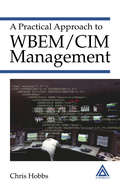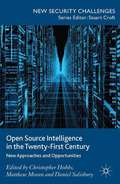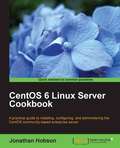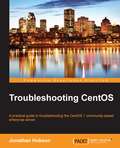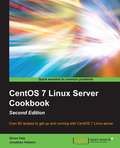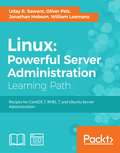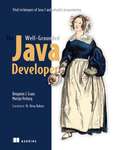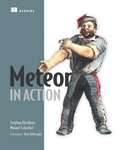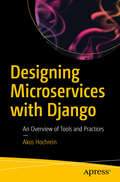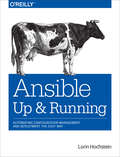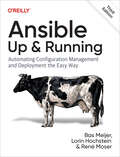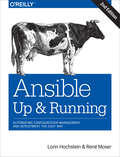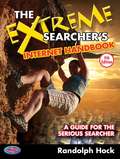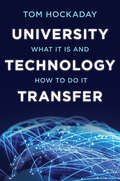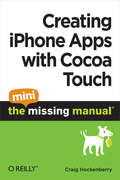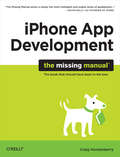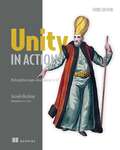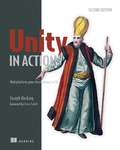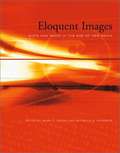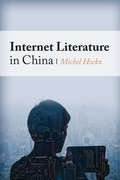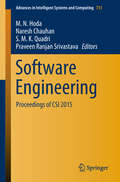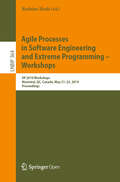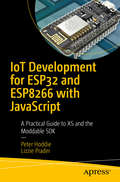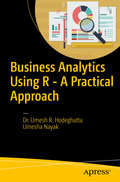- Table View
- List View
A Practical Approach to WBEM/CIM Management
by Chris HobbsSystem architects and engineers in fields such as storage networking, desktop computing, electrical power distribution, and telecommunications need a common and flexible way of managing heterogeneous devices and services. Web-Based Enterprise Management (WBEM) and its Component Information Model (CIM) provide the architecture, language, interfaces,
Open Source Intelligence in the Twenty-First Century
by Christopher Hobbs Matthew Moran Daniel SalisburyThis edited book provides an insight into the new approaches, challenges and opportunities that characterise open source intelligence (OSINT) at the beginning of the twenty-first century. It does so by considering the impacts of OSINT on three important contemporary security issues: nuclear proliferation, humanitarian crises and terrorism.
IT Asset Management A Pocket Survival Guide
by Martyn HobbsIT Asset Management: A Pocket Survival Guideis a quick reference style guide, addressing such serious issues with a fresh and pragmatic approach. Aimed at IT professionals who have been tasked with putting in place Asset Management disciplines, it first provides a commonsense introduction to the key processes outlined in the Information Technology Infrastructure Library (ITIL(r)), before proceeding to explain the various milestones of an Asset Management projec
CentOS 6 Linux Server Cookbook
by Jonathan HobsonPresented in a step by step, easy to read tutorial style, this book presents the reader with real world solutions to every aspect of CentOS 6. "CentOS 6 Linux Server Cookbook" is for those professionals, students and enthusiasts who want a down-to-earth or hands-on approach to installing, configuring and running a Centos 6 server. Where a new user may experience this book as a series of solutions, a more experienced user will find a basis on which you can develop your existing skills. So rest assured, there is something for everyone and regardless of your current level of experience, if you are interested in using CentOS 6, then this is the book that offers the insight you need to move forward and master your server.
Troubleshooting CentOS
by Jonathan HobsonIt is assumed that you will already have a server up and running, you have a good working knowledge of CentOS, and you are comfortable with the concept of working with those services used by your server.
CentOS 7 Linux Server Cookbook - Second Edition
by Jonathan Hobson Oliver PelzOver 80 recipes to get up and running with CentOS 7 Linux server About This Book * A practical guide to install, configure, administer and maintain CentOS 7 servers * An in-depth guide to the CentOS 7 operating system, exploring its various new features and changes in server administration * Presents tricks and solutions to tackle common server issues with the help of practical examples and real-life scenarios Who This Book Is For This book is targeted at beginner and more experienced system administrators alike who want to use CentOS as their server solution. Readers do not need much pre-knowledge or experience at all to work with this book. What You Will Learn * Install and configure CentOS 7 Linux server system from scratch using normal and advanced methods * Maintain a performance-based and secure server solution by deploying expert configuration advice and managing software packages * Monitor, manage and develop your server's file system to maintain a stable performance * Gain best practice methods on sharing files and resources through a network * Install and configure common standard services such as web, mail, FTP, database and domain name server technologies * Introduce you to the world of operating-system-level virtualization using the Docker platform. * Understand the fundamentals of the Security-Enhanced Linux access control architecture * Monitor your IT infrastructure using Nagios In Detail This book will provide you with a comprehensive series of starting points that will give you direct access to the inner workings of the latest CentOS version 7 and help you trim the learning curve to master your server. You will begin with the installation and basic configuration of CentOS 7, followed by learning how to manage your system, services and software packages. You will then gain an understanding of how to administer the file system, secure access to your server and configure various resource sharing services such as file, printer and DHCP servers across your network. Further on, we cover advanced topics such as FTP services, building your own DNS server, running database servers, and providing mail and web services. Finally, you will get a deep understanding of SELinux and you will learn how to work with Docker operating-system virtualization and how to monitor your IT infrastructure with Nagios. By the end of this book, you will have a fair understanding of all the aspects of configuring, implementing and administering CentOS 7 Linux server and how to put it in control. Style and approach This book is a practical reference guide with hands-on examples and solutions to real-world administration problems. It covers in-depth and comprehensive information on CentOS 7 and its new features.
Linux: Powerful Server Administration
by Jonathan Hobson Oliver Pelz Uday R. Sawant William LeemansGet hands-on recipes to make the most of Ubuntu Server, CentOS 7 Linux Server and RHEL 7 Server About This Book • Get Linux servers up and running in seconds, • In-depth guide to explore new features and solutions in server administration • Maintain performance and security of your server solution by deploying expert configuration advice Who This Book Is For This Learning Path is intended for system administrators with a basic understanding of Linux operating systems and written with the novice-to-intermediate Linux user in mind. To get the most of this Learning Path, you should have a working knowledge of basic system administration and management tools. What You Will Learn • Set up high performance, scalable, and fault-tolerant back ends with web and database servers • Facilitate team communication with a real-time chat service and collaboration tools • Monitor, manage and develop your server's file system to maintain a stable performance • Gain best practice methods on sharing files and resources through a network • Install and configure common standard services such as web, mail, FTP, database and domain name server technologies • Create kickstart scripts to automatically deploy RHEL 7 systems • Use Orchestration and configuration management tools to manage your environment In Detail Linux servers are frequently selected over other server operating systems for their stability, security and flexibility advantages.This Learning Path will teach you how to get up and running with three of the most popular Linux server distros: Ubuntu Server, CentOS 7 Server, and RHEL 7 Server. We will begin with the Ubuntu Server and show you how to make the most of Ubuntu's advanced functionalities. Moving on, we will provide you with all the knowledge that will give you access to the inner workings of the latest CentOS version 7. Finally, touching RHEL 7, we will provide you with solutions to common RHEL 7 Server challenges.This Learning Path combines some of the best that Packt has to offer in one complete, curated package. It includes content from the following Packt products: 1)Ubuntu Server Cookbook 2)CentOS 7 Linux Server Cookbook, Second Edition 3)Red Hat Enterprise Linux Server Cookbook Style and approach This easy-to-follow practical guide contains hands on examples and solutions to real word administration problems and problems faced when building your RHEL 7 system from scratch using orchestration tools.
Arduino in Action
by Jordan Hochenbaum Joshua Noble Martin EvansSummaryArduino in Action is a hands-on guide to prototyping and building electronics using the Arduino platform. Suitable for both beginners and advanced users, this easy-to-follow book begins with the basics and then systematically guides you through projects ranging from your first blinking LED through connecting Arduino to devices like game controllers or your iPhone.About the TechnologyArduino is an open source do-it-yourself electronics platform that supports a mind-boggling collection of sensors and actuators you can use to build anything you can imagine. Even if you've never attempted a hardware project, this easy-to-follow book will guide you from your first blinking LED through connecting Arduino to your iPhone.About this BookArduino in Action is a hands-on guide to prototyping and building DIY electronics. You'll start with the basics—unpacking your board and using a simple program to make something happen. Then, you'l attempt progressively more complex projects as you connect Arduino to motors, LCD displays, Wi-Fi, GPS, and Bluetooth. You'll explore input/output sensors, including ultrasound, infrared, and light, and then use them for tasks like robotic obstacle avoidance.Arduino programs look a lot like C or C++, so some programming skill is helpful.What's InsideGetting started with Arduino—no experience required!Writing programs for ArduinoSensing and responding to eventsRobots, flying vehicles, Twitter machines, LCD displays, and more!Purchase of the print book includes a free eBook in PDF, Kindle, and ePub formats from Manning Publications.About the AuthorsMartin Evans is a professional developer, a lifelong electronics enthusiast, and the creator of an Arduino-based underwater ROV. Joshua Noble is an author and creative technologist who works with smart spaces. Jordan Hochenbaum uses Arduino to explore musical expression and creative interaction.Table of ContentsPart 1 Getting startedChapter 1 Hello ArduinoChapter 2 Digital input and outputChapter 3 Simple projects: input and outputPart 2 Putting Arduino to workChapter 4 Extending ArduinoChapter 5 Arduino in motionChapter 6 Object detectionChapter 7 LCD displaysChapter 8 CommunicationsChapter 9 Game onChapter 10 Integrating the Arduino with iOSChapter 11 Making wearablesChapter 12 Adding shieldsChapter 13 Software integration
Meteor in Action
by Stephan Hochhaus Manuel SchoebelSummaryMeteor in Action teaches you full-stack web development using the Meteor platform. It starts with an overview of a Meteor application, revealing the unique nature of Meteor's end-to-end application model. Then you'll dive into the Blaze templating engine, discover Meteor's reactive data sources model, learn simple and advanced routing techniques, and practice managing users, permissions, and roles. Purchase of the print book includes a free eBook in PDF, Kindle, and ePub formats from Manning Publications.About the BookYou might call Meteor a reactive, isomorphic, full-stack web development framework. Or, like most developers who have tried it, you might just call it awesome. Meteor is a JavaScript-based framework for both client and server web and mobile applications. Meteor applications react to changes in data instantly, so you get impossibly responsive user experiences, and the consistent build process, unified front- and back-end package system, and one-command deploys save you time at every step from design to release.Meteor in Action teaches you full-stack web development with Meteor. It starts by revealing the unique nature of Meteo's end-to-end application model. Through real-world scenarios, you'll dive into the Blaze templating engine, discover Meteor's reactive data sources model, learn routing techniques, and practice managing users, permissions, and roles. Finally, you'll learn how to deploy Meteor on your server and scale efficiently.What's InsideBuilding your first real-time applicationUsing MongoDB and other reactive data sourcesCreating applications with Iron RouterDeploying and scaling your applicationsAbout the ReaderReaders need to know the basics of JavaScript and understand general web application design.About the AuthorsStephan Hochhaus and Manuel Schoebel are veteran web developers who have worked with Meteor since its infancy.Table of ContentsPART 1 LOOK—A SHOOTING STAR!A better way to build appsMy fridge! A reactive gamePART 2 3, 2, 1—IMPACT!Working with templatesWorking with dataFully reactive editingUsers, authentications, and permissionsExchanging dataRouting using Iron.RouterThe package systemAdvanced server methodsPART 3 LEAVING THE CRATERBuilding and debuggingGoing into production
Designing Microservices with Django: An Overview of Tools and Practices
by Akos HochreinExplore microservices using the Python-based Django framework and review the benefits and drawbacks of them. This book will examine what microservices look like, how they talk to each other, and how they are crafted using the Python programming language and the Django web framework.You’ll start by understanding what the key differences are between microservices and monolithic architectures. The book then does a deep dive into how microservices are built and what common models have emerged in our industry. You’ll also take an extensive look at communication and ownership patterns and examine methodologies to speed up your architecture evolution by writing less but more distributed code using the Python programming language and the Django web framework. By the end of the book, you’ll have a solid understanding of microservices architectures. Armed with a comprehensive and solid toolset, you can begin working toward systems that are more scalable, resilient, and maintainable. What You’ll LearnUnderstand the benefits and drawbacks of adopting microservicesDesign systems and architecture for resiliency and distributed ownershipWork with tools for scaling distributed system both in technical and organizational dimensionsExamine the essentials of the Django web framework
Ansible: Up and Running
by Lorin HochsteinAmong the many configuration management tools available, Ansible has some distinct advantages--it's minimal in nature, you don't need to install anything on your nodes, and it has an easy learning curve. This practical guide shows you how to be productive with this tool quickly, whether you're a developer deploying code to production or a system administrator looking for a better automation solution.Author Lorin Hochstein shows you how to write playbooks (Ansible's configuration management scripts), manage remote servers, and explore the tool's real power: built-in declarative modules. You'll discover that Ansible has the functionality you need and the simplicity you desire.Understand how Ansible differs from other configuration management systemsUse the YAML file format to write your own playbooksLearn Ansible's support for variables and factsWork with a complete example to deploy a non-trivial applicationUse roles to simplify and reuse playbooksMake playbooks run faster with ssh multiplexing, pipelining, and parallelismDeploy applications to Amazon EC2 and other cloud platformsUse Ansible to create Docker images and deploy Docker containers
Ansible: Automating Configuration Management And Deployment The Easy Way
by Lorin Hochstein Bas Meijer René MoserAmong the many configuration management tools available, Ansible has some distinct advantages: It's minimal in nature. You don't need to install agents on your nodes. And there's an easy learning curve. With this updated third edition, you'll quickly learn how to be productive with Ansible whether you're a developer deploying code or a system administrator looking for a better automation solution.Authors Bas Meijer, Lorin Hochstein, and Rene Moser show you how to write playbooks (Ansible's configuration management scripts), manage remote servers, and explore the tool's real power: built-in declarative modules. You'll learn how Ansible has all the functionality you need--and the simplicity you desire.Explore Ansible configuration management and deploymentManage Linux, Windows, and network devicesLearn how to apply Ansible best practicesUnderstand how to use the new collections formatCreate custom modules and plug-insGenerate reusable Ansible content for open source middlewareBuild container images, images for cloud instances, and cloud infrastructureAutomate CI/CD development environmentsLearn how to use Ansible Automation Platform for DevOps
Ansible Up and Running: Automating Configuration Management and Deployment the Easy Way (2nd Edition)
by Lorin Hochstein Rene MoserAmong the many configuration management tools available, Ansible has some distinct advantages—it’s minimal in nature, you don’t need to install anything on your nodes, and it has an easy learning curve. With this updated second edition, you’ll learn how to be productive with this tool quickly, whether you’re a developer deploying code to production or a system administrator looking for a better automation solution.Authors Lorin Hochstein and René Moser show you how to write playbooks (Ansible’s configuration management scripts), manage remote servers, and explore the tool’s real power: built-in declarative modules. You’ll discover that Ansible has the functionality you need—and the simplicity you desire.Manage Windows machines, and automate network device configurationManage your fleet from your web browser with Ansible TowerUnderstand how Ansible differs from other configuration management systemsUse the YAML file format to write your own playbooksWork with a complete example to deploy a non-trivial applicationDeploy applications to Amazon EC2 and other cloud platformsCreate Docker images and deploy Docker containers with AnsibleThis book is best read start to finish, with later chapters building on earlier ones. Because it’s written in a tutorial style, you can follow along on your own machine. Most examples focus on web applications.
The Extreme Searcher's Internet Handbook: A Guide For The Serious Searcher
by Randolph HockAn essential guide for anyone who conducts research on the internet--including librarians, teachers, students, business professionals, and writers--this fully revised handbook details what users must know to take full advantage of internet search tools and resources. From the latest online tools to the new and enhanced services offered by standbys such as Google, the major search engines and their myriad of possibilities are thoroughly discussed. This revamped fourth edition also features chapters on fact-checking sites and popular social networking sites as well as a collection of up-to-date screenshots for visual reference. For those with little to moderate searching experience, friendly, easy-to-follow guidelines to the world of Web research are provided, while experienced searchers will discover new perspectives on content and techniques.
University Technology Transfer: What It Is and How to Do It
by Tom HockadayDemystifying technology transfer—an increasingly important but little-understood aspect of research universities' mission.How do we transfer the brilliance of university research results into new products, services, and medicines to benefit society? University research is creating the technologies of tomorrow in the fields of medicine, engineering, information technology, robotics, and artificial intelligence. These early-stage technologies need investment from existing and new businesses to benefit society. But how do we connect university research outputs with business and investors?This process, Tom Hockaday explains, is what university technology transfer is all about: identifying, protecting, and marketing university research outputs in order to shift opportunities from the university into business. In this detailed introductory book—a comprehensive overview of and guide to the subject—Hockaday, an internationally recognized technology transfer expert, offers up his insider observations, opinions, and suggestions about university technology transfer. He also explains how to develop, strategically operate, and fund university technology transfer offices while behaving in accordance with the central mission of the university.Aimed at people who work in or with university technology transfer offices, as well as anyone who wants to learn the basics of what is involved, University Technology Transfer speaks to a global audience. Tackling a complex topic in clear language, the book reveals the impressive scale of patenting, licensing, and spin-out company creation while also demonstrating that university technology transfer is a commercial activity with benefits that go well beyond the opportunity to make money.
Creating iPhone Apps with Cocoa Touch: The Mini Missing Manual
by Craig HockenberryCreating iPhone Apps with Cocoa Touch: The Mini Missing Manual walks you through developing your first iPhone App and introduces you to your programming environments and tools: Cocoa Touch, Interface Builder, Xcode, and the Objective-C programming language. If you're a Java or C developer, this eBook is your fast track to App development. This eBook is adapted from parts of iPhone App Development: The Missing Manual.
iPhone App Development: The Missing Manual
by Craig HockenberryAnyone with programming experience can learn how to write an iPhone app. But if you want to build a great app, there's a lot more to it than simple coding: you also need to know how design and market your creation. This easy-to-follow guide walks you through the entire process, from sketching out your idea to promoting the finished product. Get to know the tools for developing your iPhone app Design a great app before you start coding Build a complex app with Xcode and Interface Builder Decide how to brand your app-then beta-test that brand in the real world Learn the inside scoop on how to get your app into the App Store Promote your product, track sales, and build a strong customer following
Unity in Action, Third Edition: Multiplatform game development in C#
by Joe HockingThis hands-on beginners guide gets you building games fast, all with the awesome Unity engine! You&’ll speed past the basics and use your existing coding skills to create 2D, 3D, and AR/VR games.In Unity in Action, Third Edition, you will learn how to: Create characters that run, jump, and bump into things Build 3D first-person shooters and third-person action games Construct 2D card games and side-scrolling platformers Script enemies with AI Improve game graphics by importing models and images Design an intuitive user interface for your games Play music and spatially-aware sound effects Connect your games to the internet for online play Deploy your games to desktop, mobile, and the web Thousands of new game developers have chosen Joe Hocking&’s Unity in Action as their first step toward Unity mastery. Starting with the initial groundwork of a new game development project, you&’ll quickly start writing custom code instead of clicking together premade scripts. This fully updated third edition comes packed with fully refreshed graphics, Unity&’s latest features, and coverage of augmented and virtual reality toolkits. You'll master the Unity toolset from the ground up, learning the skills to go from application coder to game developer. Foreword by Jesse Schell. About the technology Writing games is rewarding and fun—and with Unity, it&’s easy to get started! Unity handles the heavy lifting, so you can focus on game play, graphics, and user experience. C# support and a huge ecosystem of prebuilt components help even first-time developers go from the drawing board to the screen fast. About the book Unity in Action, Third Edition teaches you to create games with the Unity game platform. It&’s many 2D, 3D, and AR/VR game examples give you hands-on experience with Unity&’s workflow tools and state-of-the-art rendering engine. This fully updated third edition presents new coverage of Unity&’s XR toolkit and shows you how you can start building with virtual and augmented reality. What's inside Create characters that run, jump, and bump into things Script enemies with AI Play music and spatially-aware sound effects Deploy your games to desktop, mobile, and the web About the reader For programmers who know any object-oriented programming language. Examples are in C#. About the author Joe Hocking is a software engineer and Unity expert specializing in interactive media development. Table of Contents PART 1 FIRST STEPS 1 Getting to know Unity 2 Building a demo that puts you in 3D space 3 Adding enemies and projectiles to the 3D game 4 Developing graphics for your game PART 2 GETTING COMFORTABLE 5 Building a Memory game using Unity&’s 2D functionality 6 Creating a basic 2D platformer 7 Putting a GUI onto a game 8 Creating a third-person 3D game: Player movement and animation 9 Adding interactive devices and items within the game PART 3 STRONG FINISH 10 Connecting your game to the internet 11 Playing audio: Sound effects and music 12 Putting the parts together into a complete game 13 Deploying your game to players&’ devices
Unity in Action: Multiplatform game development in C#
by Joseph HockingSummaryManning's bestselling and highly recommended Unity book has been fully revised! Unity in Action, Second Edition teaches you to write and deploy games with the Unity game development platform. You'll master the Unity toolset from the ground up, adding the skills you need to go from application coder to game developer.Foreword by Jesse Schell, author of The Art of Game DesignPurchase of the print book includes a free eBook in PDF, Kindle, and ePub formats from Manning Publications.About the TechnologyBuild your next game without sweating the low-level details. The Unity game development platform handles the heavy lifting, so you can focus on game play, graphics, and user experience. With support for C# programming, a huge ecosystem of production-quality prebuilt assets, and a strong dev community, Unity can get your next great game idea off the drawing board and onto the screen!About the BookUnity in Action, Second Edition teaches you to write and deploy games with Unity. As you explore the many interesting examples, you'll get hands-on practice with Unity's intuitive workflow tools and state-of-the-art rendering engine. This practical guide exposes every aspect of the game dev process, from the initial groundwork to creating custom AI scripts and building easy-to-read UIs. And because you asked for it, this totally revised Second Edition includes a new chapter on building 2D platformers with Unity's expanded 2D toolkit. What's InsideRevised for new best practices, updates, and more!2D and 3D gamesCharacters that run, jump, and bump into thingsConnect your games to the internetAbout the ReaderYou need to know C# or a similar language. No game development knowledge is assumed.About the AuthorJoe Hocking is a software engineer and Unity expert specializing in interactive media development.Table of ContentsPART 1 - First stepsGetting to know Unity Building a demo that puts you in 3D space Adding enemies and projectiles to the 3D game Developing graphics for your game PART 2 - Getting comfortableBuilding a Memory game using Unity's 2D functionality Creating a basic 2D Platformer Putting a GUI onto a game Creating a third-person 3D game: player movement and animationAdding interactive devices and items within the gamePART 3 - Strong finishConnecting your game to the internet Playing audio: sound effects and music Putting the parts together into a complete game Deploying your game to players' devices
Eloquent Images: Word and Image in the Age of New Media
by Mary E. Hocks Michelle R. KendrickThe emergence of New Media has stimulated debate about the power of the visual to dethrone the cultural prominence of textuality and print. Some scholars celebrate the proliferation of digital images, arguing that it suggests a return to a pictorial age when knowledge was communicated through images as well as through words. Others argue that the inherent conflict between texts and images creates a battleground between the feminized, seductive power of images and the masculine rationality of the printed word. Eloquent Imagessuggests that these debates misunderstand the dynamic interplay that has always existed between word and image. Arguing that the complex relationship between text and image in New Media does not represent a radical rupture from the past, the book examines rhetorical and cultural uses of word and image both historically and currently. It shows that complex, interpenetrating relationships between verbal and visual communication systems were already evident in hieroglyphic writing and in ancient rhetoric and persist in the work of classical rhetoricians, in cultural studies of technology, even in the binary code distinctions of digital environments. The essays blend theory, critique, and design practice to explore the often contradictory relations of word and image. All of them call for theoretically grounded approaches to hypermedia design.
Internet Literature in China (Global Chinese Culture)
by Michel HockxSince the 1990s, Chinese literary enthusiasts have explored new spaces for creative expression online, giving rise to a modern genre that has transformed Chinese culture and society. Ranging from the self-consciously avant-garde to the pornographic, web-based writing has introduced innovative forms, themes, and practices into Chinese literature and its aesthetic traditions. Conducting the first comprehensive survey in English of this phenomenon, Michel Hockx describes in detail the types of Chinese literature taking shape right now online and their novel aesthetic, political, and ideological challenges. Offering a unique portal into postsocialist Chinese culture, he presents a complex portrait of internet culture and control in China that avoids one-dimensional representations of oppression. The Chinese government still strictly regulates the publishing world, yet it is growing increasingly tolerant of internet literature and its publishing practices while still drawing a clear yet ever-shifting ideological bottom line. Hockx interviews online authors, publishers, and censors, capturing the convergence of mass media, creativity, censorship, and free speech that is upending traditional hierarchies and conventions within China—and across Asia.
Software Engineering: Proceedings of CSI 2015 (Advances in Intelligent Systems and Computing #731)
by M. N. Hoda Naresh Chauhan S. M. Quadri Praveen Ranjan SrivastavaThis book presents selected proceedings of the annual convention of the Computer Society of India. Divided into 10 topical volumes, the proceedings present papers on state-of-the-art research, surveys, and succinct reviews. They cover diverse topics ranging from communications networks to big data analytics, and from system architecture to cyber security. This book focuses on Software Engineering, and informs readers about the state of the art in software engineering by gathering high-quality papers that represent the outcomes of consolidated research and innovations in Software Engineering and related areas. In addition to helping practitioners and researchers understand the chief issues involved in designing, developing, evolving and validating complex software systems, it provides comprehensive information on developing professional careers in Software Engineering. It also provides insights into various research issues such as software reliability, verification and validation, security and extensibility, as well as the latest concepts like component-based development, software process models, process-driven systems and human-computer collaborative systems.
Agile Processes in Software Engineering and Extreme Programming – Workshops: XP 2019 Workshops, Montréal, QC, Canada, May 21–25, 2019, Proceedings (Lecture Notes in Business Information Processing #364)
by Rashina HodaThis open access book constitutes the research workshops, doctoral symposium and panel summaries presented at the 20th International Conference on Agile Software Development, XP 2019, held in Montreal, QC, Canada, in May 2019.XP is the premier agile software development conference combining research and practice. It is a hybrid forum where agile researchers, academics, practitioners, thought leaders, coaches, and trainers get together to present and discuss their most recent innovations, research results, experiences, concerns, challenges, and trends. Following this history, for both researchers and seasoned practitioners XP 2019 provided an informal environment to network, share, and discover trends in Agile for the next 20 years. Research papers and talks submissions were invited for the three XP 2019 research workshops, namely, agile transformation, autonomous teams, and large scale agile. This book includes 15 related papers. In addition, a summary for each of the four panels at XP 2019 is included. The panels were on security and privacy; the impact of the agile manifesto on culture, education, and software practices; business agility – agile’s next frontier; and Agile – the next 20 years.
IoT Development for ESP32 and ESP8266 with JavaScript: A Practical Guide to XS and the Moddable SDK
by Peter Hoddie Lizzie PraderThis book introduces a new approach to embedded development, grounded in modern, industry-standard JavaScript. Using the same language that powers web browsers and Node.js, the Moddable SDK empowers IoT developers to apply many of the same tools and techniques used to build sophisticated websites and mobile apps. The Moddable SDK enables you to unlock the full potential of inexpensive microcontrollers like the ESP32 and ESP8266. Coding for these microcontrollers in C or C++ with the ESP-IDF and Arduino SDKs works for building basic products but doesn't scale to handle the increasingly complex IoT products that customers expect. The Moddable SDK adds the lightweight XS JavaScript engine to those traditional environments, accelerating development with JavaScript while keeping the performance benefits of a native SDK. Building user interfaces and communicating over the network are two areas where JavaScript really shines. IoT Development for ESP32 and ESP8266 with JavaScript shows you how to build responsive touch screen user interfaces using the Piu framework. You'll learn how easy it is to securely send and receive JSON data over Wi-Fi with elegant JavaScript APIs for common IoT protocols, including HTTP/HTTPS, WebSocket, MQTT, and mDNS. You'll also learn how to integrate common sensors and actuators, Bluetooth Low Energy (BLE), file systems, and more into your projects, and you'll see firsthand how JavaScript makes it easier to combine these diverse technologies. If you're an embedded C or C++ developer who has never worked in JavaScript, don't worry. This book includes an introduction to the JavaScript language just for embedded developers experienced with C or C++. What You'll Learn Building, installing, and debugging JavaScript projects on the ESP32 and ESP8266 Using modern JavaScript for all aspects of embedded development with the Moddable SDK Developing IoT products with animated user interfaces, touch input, networking, BLE, sensors, actuators, and more Who This Book Is For Professional embedded developers who want the speed, flexibility, and power of web development in their embedded software work Makers who want a faster, easier way to build their hobby projects Web developers working in JavaScript who want to extend their skills to hardware products
Business Analytics Using R - A Practical Approach: A Practical Approach
by Umesh R. Hodeghatta Umesh NayakLearn the fundamental aspects of the business statistics, data mining, and machine learning techniques required to understand the huge amount of data generated by your organization. This book explains practical business analytics through examples, covers the steps involved in using it correctly, and shows you the context in which a particular technique does not make sense. Further, Practical Business Analytics using R helps you understand specific issues faced by organizations and how the solutions to these issues can be facilitated by business analytics. This book will discuss and explore the following through examples and case studies: An introduction to R: data management and R functions The architecture, framework, and life cycle of a business analytics project Descriptive analytics using R: descriptive statistics and data cleaning Data mining: classification, association rules, and clustering Predictive analytics: simple regression, multiple regression, and logistic regression This book includes case studies on important business analytic techniques, such as classification, association, clustering, and regression. The R language is the statistical tool used to demonstrate the concepts throughout the book. What You Will Learn * Write R programs to handle data * Build analytical models and draw useful inferences from them * Discover the basic concepts of data mining and machine learning * Carry out predictive modeling * Define a business issue as an analytical problem Who This Book Is For Beginners who want to understand and learn the fundamentals of analytics using R. Students, managers, executives, strategy and planning professionals, software professionals, and BI/DW professionals.
